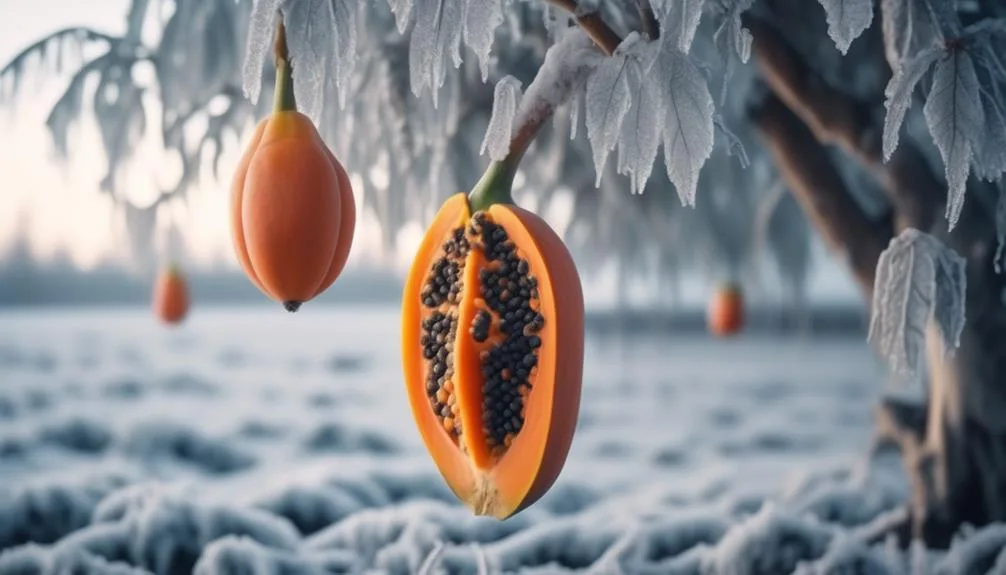Papaya trees, known for thriving in warm climates, face a challenge when it comes to frost. Their survival depends on factors like the severity of the frost, the tree's age and health, and protective measures.
Let's explore how papaya trees cope with frost and what strategies can help them endure the cold.
Key Takeaways
- Papaya trees require a temperature range of 75-90 degrees Fahrenheit for optimal growth and fruit production.
- They are sensitive to cold temperatures and cannot withstand frost.
- Frost causes significant damage to papaya trees' tender foliage and fruit, leading to stunted growth and reduced yield.
- Implementing effective protection measures, such as plant covers and additional warmth sources, is crucial for safeguarding papaya trees from frost damage.
Ideal Temperature Range for Papaya Trees
To thrive, papaya trees require a consistent temperature range of 75-90 degrees Fahrenheit. This ideal climate allows for optimal growth and fruit production. Papaya trees are sensitive to cold temperatures and can't withstand frost.
The growth requirements of papaya trees include well-draining soil, full sun, and warm temperatures. In terms of climate adaptation, papaya trees are best suited for tropical and subtropical regions, where the temperature remains consistently warm.
In areas with cooler climates, it's essential to provide protection from cold temperatures, such as using frost cloth or planting near buildings to create a warmer microclimate. Understanding the ideal temperature range for papaya trees is crucial for their successful cultivation and fruit yield.
Impact of Frost on Papaya Trees
Exposed to frost, papaya trees suffer significant damage to their tender foliage and fruit, often resulting in stunted growth and reduced yield. The impact of frost on papaya trees can be detrimental, as they're adapted to warm tropical climates and lack resilience to cold temperatures.
When frost occurs, the tender leaves and developing fruit are highly susceptible to damage, leading to a decrease in the overall productivity of the tree. Additionally, frost can hinder the tree's ability to adapt to its environment, impacting its long-term climate adaptation.
It's important to take proactive measures to protect papaya trees from frost, such as covering them with frost cloths or utilizing frost protection sprays. By understanding the impact of frost on papaya trees, you can better support their resilience and overall health.
Frost Protection Measures for Papaya Trees
Considering the vulnerability of papaya trees to frost, implementing effective protection measures is crucial for safeguarding their growth and productivity.
When facing cold weather, it's essential to shield your papaya trees. One effective method is using plant covers to create a barrier against frost. These covers help trap heat from the soil and prevent the cold air from reaching the trees, offering crucial protection during chilly nights. Choose covers that are specifically designed for cold weather protection and ensure they're securely in place to maximize their effectiveness.
Additionally, consider using other protective measures such as light bulbs or heaters to create warmth around the trees.
Signs of Frost Damage on Papaya Trees
If your papaya trees have been exposed to frost, it's essential to be able to recognize the signs of damage to effectively address any issues and support their recovery.
Here are some key signs of frost damage on papaya trees:
- Stunted Growth Rate
- Check for slowed or stunted growth compared to the tree's usual development.
- Monitor the overall health of the tree to ensure it isn't struggling to recover from the frost.
- Leaf Discoloration
- Look for changes in leaf color, such as a darkening or browning of the leaves.
- Keep an eye out for wilting or drooping leaves, which can indicate frost damage affecting the vascular system.
Being able to identify these signs promptly can help in implementing appropriate measures to aid in the recovery of your papaya trees after frost exposure.
How to Revive Frost-Damaged Papaya Trees
To revive frost-damaged papaya trees, assess the extent of the damage and take immediate action to promote recovery. Begin by trimming off any blackened or mushy parts of the tree to prevent further decay. Prune the branches to allow new growth to emerge.
Provide extra care during the winter months by covering the tree with a frost cloth or blanket during cold nights. Water the tree sparingly and avoid fertilizing until new growth appears.
Apply a layer of organic mulch around the base of the tree to help retain moisture and regulate soil temperature. Keep a close eye on the tree's progress and continue to provide the necessary tree rehabilitation and winter care.
With patience and proper treatment, your papaya tree can rebound from frost damage and thrive once again.
Conclusion
In colder climates, protecting your papaya trees from frost is essential. By monitoring the temperature and taking proactive measures, such as covering or bringing them indoors when frost is expected, you can help ensure their survival.
Even if your trees do suffer frost damage, don't lose hope – with proper care, they can often be revived.
With the right precautions, you can enjoy healthy papaya trees all year round, providing a fruitful and vibrant addition to your garden.

